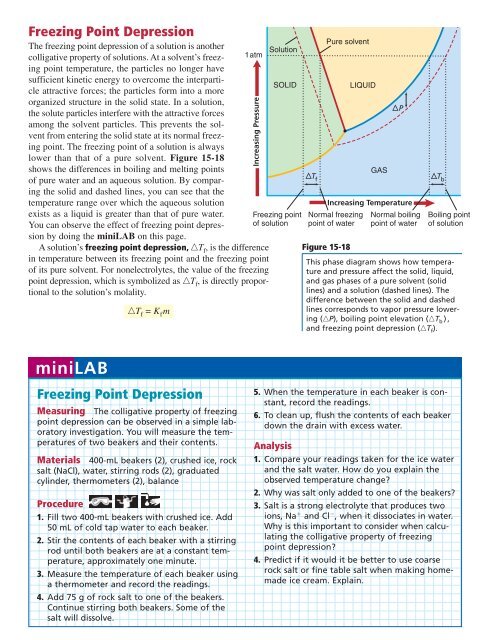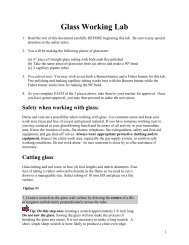Chapter 15: Solutions - Weironline.net
Chapter 15: Solutions - Weironline.net
Chapter 15: Solutions - Weironline.net
You also want an ePaper? Increase the reach of your titles
YUMPU automatically turns print PDFs into web optimized ePapers that Google loves.
Freezing Point Depression<br />
The freezing point depression of a solution is another<br />
colligative property of solutions. At a solvent’s freezing<br />
point temperature, the particles no longer have<br />
sufficient ki<strong>net</strong>ic energy to overcome the interparticle<br />
attractive forces; the particles form into a more<br />
organized structure in the solid state. In a solution,<br />
the solute particles interfere with the attractive forces<br />
among the solvent particles. This prevents the solvent<br />
from entering the solid state at its normal freezing<br />
point. The freezing point of a solution is always<br />
lower than that of a pure solvent. Figure <strong>15</strong>-18<br />
shows the differences in boiling and melting points<br />
of pure water and an aqueous solution. By comparing<br />
the solid and dashed lines, you can see that the<br />
temperature range over which the aqueous solution<br />
exists as a liquid is greater than that of pure water.<br />
You can observe the effect of freezing point depression<br />
by doing the miniLAB on this page.<br />
A solution’s freezing point depression, �T f , is the difference<br />
in temperature between its freezing point and the freezing point<br />
of its pure solvent. For nonelectrolytes, the value of the freezing<br />
point depression, which is symbolized as �T f , is directly proportional<br />
to the solution’s molality.<br />
miniLAB<br />
�T f = K f m<br />
Freezing Point Depression<br />
Measuring The colligative property of freezing<br />
point depression can be observed in a simple laboratory<br />
investigation. You will measure the temperatures<br />
of two beakers and their contents.<br />
Materials 400-mL beakers (2), crushed ice, rock<br />
salt (NaCl), water, stirring rods (2), graduated<br />
cylinder, thermometers (2), balance<br />
Procedure<br />
1. Fill two 400-mL beakers with crushed ice. Add<br />
50 mL of cold tap water to each beaker.<br />
2. Stir the contents of each beaker with a stirring<br />
rod until both beakers are at a constant temperature,<br />
approximately one minute.<br />
3. Measure the temperature of each beaker using<br />
a thermometer and record the readings.<br />
4. Add 75 g of rock salt to one of the beakers.<br />
Continue stirring both beakers. Some of the<br />
salt will dissolve.<br />
1 atm<br />
Increasing Pressure<br />
Solution<br />
SOLID<br />
Freezing point<br />
of solution<br />
Pure solvent<br />
LIQUID<br />
�P<br />
GAS<br />
�Tf �Tb<br />
Increasing Temperature<br />
Normal freezing<br />
point of water<br />
Figure <strong>15</strong>-18<br />
Normal boiling<br />
point of water<br />
Boiling point<br />
of solution<br />
This phase diagram shows how temperature<br />
and pressure affect the solid, liquid,<br />
and gas phases of a pure solvent (solid<br />
lines) and a solution (dashed lines). The<br />
difference between the solid and dashed<br />
lines corresponds to vapor pressure lowering<br />
(�P), boiling point elevation (�T b ),<br />
and freezing point depression (�T f).<br />
5. When the temperature in each beaker is constant,<br />
record the readings.<br />
6. To clean up, flush the contents of each beaker<br />
down the drain with excess water.<br />
Analysis<br />
1. Compare your readings taken for the ice water<br />
and the salt water. How do you explain the<br />
observed temperature change?<br />
2. Why was salt only added to one of the beakers?<br />
3. Salt is a strong electrolyte that produces two<br />
ions, Na � and Cl � , when it dissociates in water.<br />
Why is this important to consider when calculating<br />
the colligative property of freezing<br />
point depression?<br />
4. Predict if it would it be better to use coarse<br />
rock salt or fine table salt when making homemade<br />
ice cream. Explain.<br />
<strong>15</strong>.3 Colligative Properties of <strong>Solutions</strong> 473




